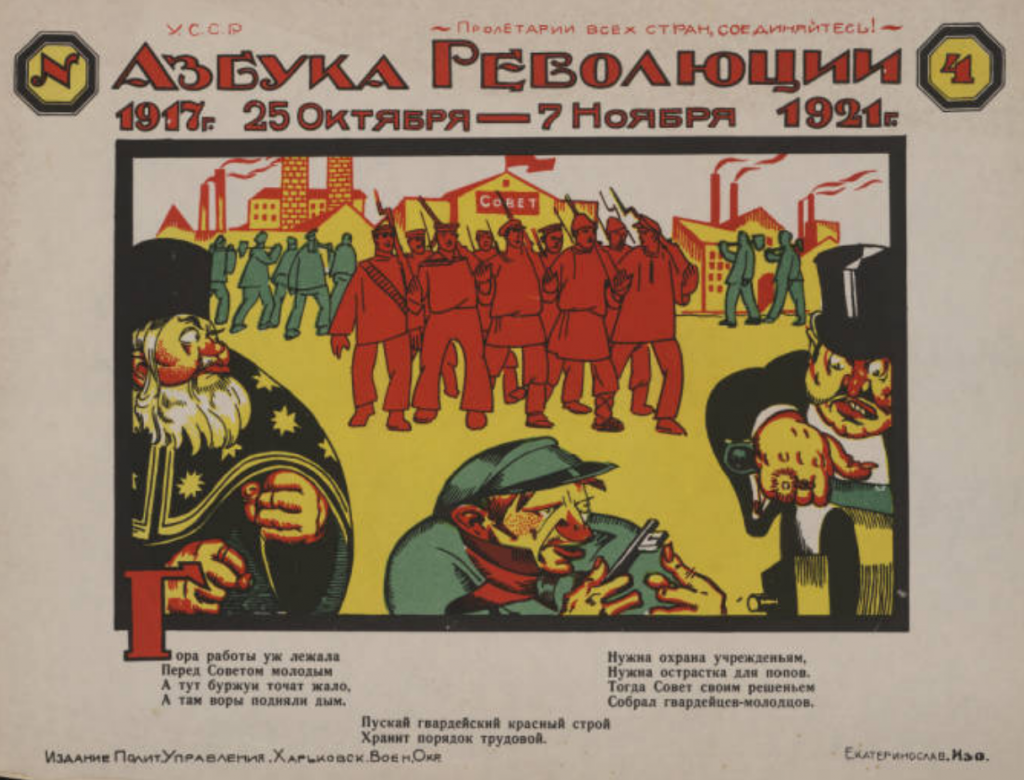
Poster titled ” Азбука Революции” (Revolution from A to Z) printed in 1921 to celebrate fourth anniversary of the “Great October Social Revolution.” Courtesy the Keston Center Archives.
This blog post was written by Baylor Libraries intern Will Overton. Will is a senior professional writing major from Dickinson, TX working in the Office of Marketing Communication for the Libraries and ITS.
October 2017 marks the one-hundred-year anniversary of the October Revolution, which saw the overthrow of the last Russian Tsar and the rise of the Communist movement in the country. The October Revolution occurred on the morning of October 25, 1917 and lasted the entire day, ending with the Bolsheviks storming the Winter Palace and capturing the cabinet members of the Provisional Government. The events of October 25 ended the months of unrest that defined 1917 for Russia. For almost the entirety of October 1917, major changes occurred in Russia including uprisings within the Russian Army.
After a month of ever increasing unrest, Lenin urged the Bolshevik Central Committee to overthrow and remove the Provisional Government “this very night.” At the same time, he publicly called for the people to revolt against the government. Lenin’s calls for revolution occurred on October 24th, the eve of the revolution. Despite what the Bolshevik government would later claim, the revolution claimed no casualties and there was minimal fighting and resistance from the Provisional Government.
While doing research on the October Revolution, it was discovered that the Baylor Lariat, the preeminent source of news on campus, carried no such news story relating to the event. However, in the February 3, 1921 issue there is an article about a speaker from Russia who visited Baylor to explain what has been happening since the October Revolution. Dr. Edwin A. Ross, a professor of sociology at the University of Wisconsin, presented a lecture titled “Russia and the Soviet Republic” which helped dispel many of the rumors and misinformation that was being carried in newspapers. The lecture also backed up the facts that there had been “comparatively little bloodshed and no anarchy” despite what was being reported by the Soviet government. Ross also believed the reformations that have taken place since the October Revolution would greatly benefit their own civilization as well as the world. With hindsight, his lecture and comments can be seen as a form of naiveté, but it was a commonly accepted point of view in the early years of the Soviet Union.
For anyone interested in reading more about the October Revolution, as well as the events leading up to and after it, here are some online resources:
- http://alphahistory.com/russianrevolution/ – The Alpha History website covers a wide variety of historical topics including both World Wars, the Russian Revolution, the American and French revolutions, the history of conflict in Northern Ireland and many others. Within each historical topic are documents that give different accounts, some eye-witness, of the events surrounding the event in question. There is also an interactive timeline, a glossary of terms, biographies of everyone involved and activities to test your knowledge.
- https://www.marxists.org/history/ussr/events/revolution/index.htm – The Marxists website is similar in content but also includes many eyewitness reports of the October Revolution. Al of the documents in this website were published before 1927 and thus have fallen into the public domain. They are also available to read on the website as well as downloadable PDF documents. The book “Ten Days that Shook the World” by John Reed is a true to life account of an American journalist who was in Russia at the time of the October revolution. There are also eyewitness accounts by Leon Trotsky and Joseph Stalin, both prominent members of the Bolshevik movement. Much like the Alpha History website, there is content beyond the October Revolution and Russia.
- Bearcat – Russian Revolution – This e-book is an interesting read if you want to learn more about the perspective of the Jewish people during the Russian Revolution. The book is titled “Jewish Renaissance in the Russian Revolution” and tells the non-fictional stories of different Jewish people starting from the February Revolution in 1917 to early 1919 (should rework this sentence). In each story, the character’s lives are directly affected by the events of the Russian Revolution, even if they are not connected in any way to what is happening.
- BearCat – October Revolution in Prospect and Retrospect – In this e-book, John Eric Marot takes a look at the rise of the Bolshevik movement from 1904 to the October Revolution and beyond. Throughout the book, Marot talks about Stalinism, Trotskyism and how the leaders of Soviet Russia failed to implement their promise improvements to the Russian people (maybe rewrite part of this).
- BearCat – Russia’s Cold War – This e-book by Jonathan Haslam focuses on the effects the October Revolution had on the path Russia took in world affairs from 1917 until the Berlin Wall fell in 1989. While it talks about the October Revolution, the main draw of the book is on the impact it had on Russia over the following 70 years.
For more on the Centennial of the Russian Revolution, check out our digital exhibit.
